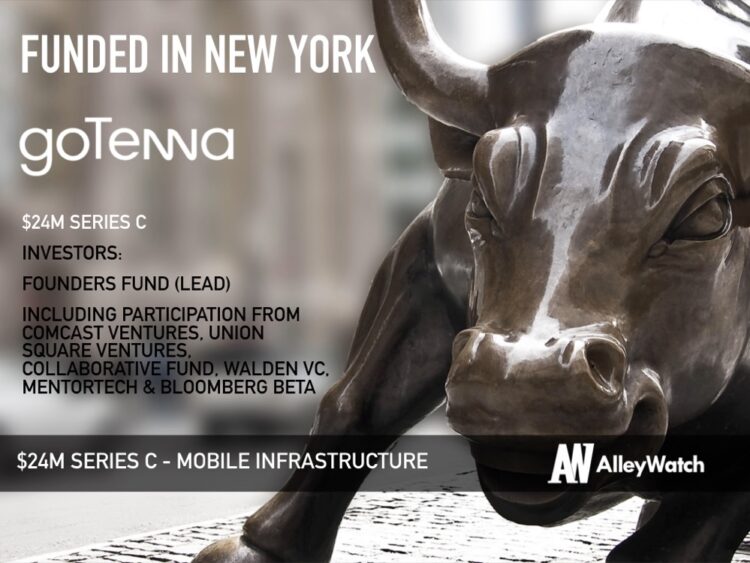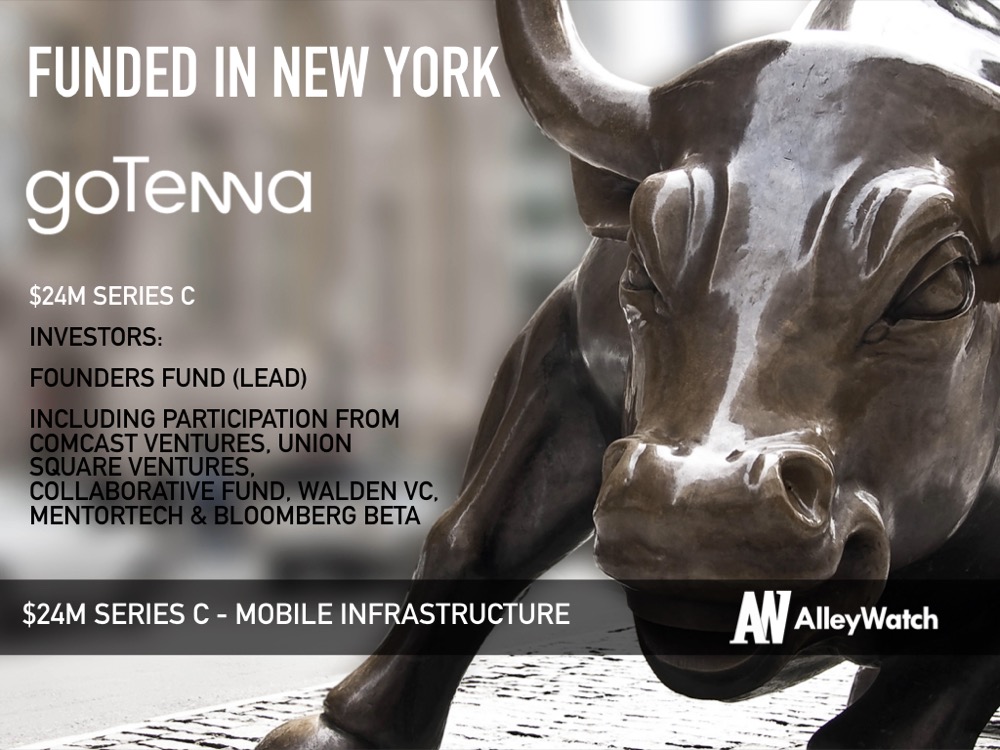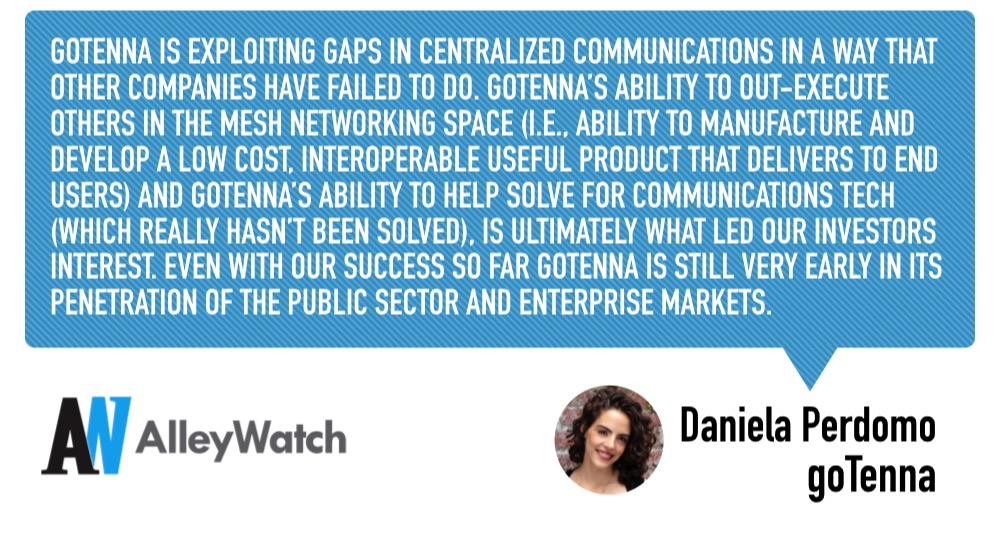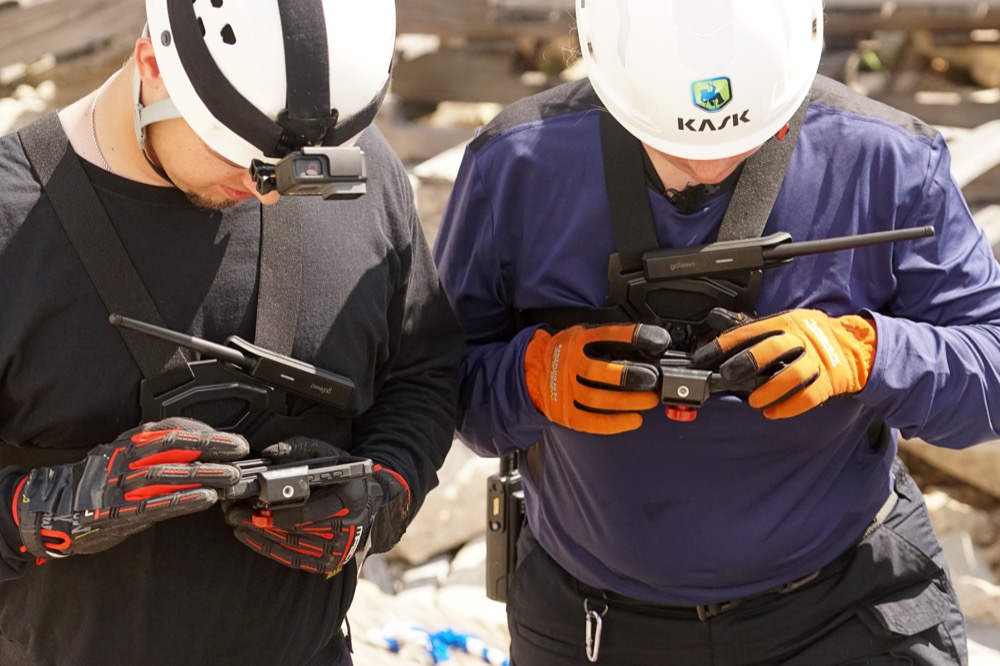Losing touch with the outside world during calamitous events like natural disasters is still a serious concern even in this age of what seems to be constant connectivity. goTenna addresses this problem with its decentralized communication infrastructure network that is virtually indestructible and designed for the times where communication may most be needed. Founded in 2012, the company’s mesh network protocol can easily pair with easy-to-use mobile apps to create bottom-up mobile, long-range connectivity without the use of any traditional grids. The company has hardware solutions that paid up with your mobile device for both consumers and professionals like emergency responders in the field for whom its critical to maintain communication.
AlleyWatch sat down with cofounder and CEO Daniela Perdomo to learn more about her personal experience with Hurricane Sandy inspired her to build goTenna, the company’s future plans, and latest round of funding, which brings its total funding raised to $40.8M across four rounds.
Who were your investors and how much did you raise?
goTenna’s $24M Series C funding round was led by Founders Fund with Comcast Ventures, Union Square Ventures, Collaborative Fund, Walden VC, MentorTech, and Bloomberg Beta also participating.
Tell us about the product or service that goTenna offers.
goTenna is building mesh networks to power programmable mobile infrastructure on a global scale with a goal to decentralize connectivity and unlock society’s last mile. goTenna’s devices pair with mobile apps, unlocking phones’ ability to create bottom-up mobile, long-range connectivity even without cell, Wi-Fi, or satellite.
 What inspired you to start goTenna?
What inspired you to start goTenna?
The inspiration for goTenna came in part due to my experience of Hurricane Sandy in 2012, which knocked down a third of all telecommunications infrastructures in the 10-state area affected by the storm. I was inspired to help those who lost touch with the outside world and create a solution that was virtually indestructible. From the very beginning, the vision for goTenna has been to create a decentralized communications infrastructure that is created from the bottom-up, increasing scale, resiliency, and access to connectivity.
How is goTenna different?
goTenna’s disruptive mesh networking protocol, Aspen Grove™, is embedded into low-cost, low-power devices and paired with easy-to-use mobile apps unlocking phones’ ability to create bottom-up mobile, long-range connectivity even without cell, Wi-Fi, or satellite. goTenna devices pair to personal computing devices, such as smartphones, providing a system on which to run the company’s Aspen Grove™ suite of mobile mesh networking protocols. goTenna devices are orders of magnitude lower-power, lower-cost, longer-range, and easier-to-use than prior state-of-the-art mesh systems, which allow operators in the field to stay situationally aware and maintain communication when other communication channels are down.
What market does goTenna target and how big is it?
goTenna targets both public sector and consumer markets. This recent financing secures an exciting development path for the company and enables goTenna to accelerate its pursuit of a $26B/year public sector opportunity, as well as invest in research and development of future applications of their modular mobile mesh architecture for decentralized connectivity.
What was the funding process like?
When raising our Series C recently, in spite of having three generations of game-changing hardware, software, and networking protocols fully commercialized (and patented), multi-million-dollar contracts from the likes of the Department of Defense and Department of Homeland Security, and real-world after-action-reports of our technology saving lives, I kept hearing VCs declare what we’ve already built “impossible.”
When raising our Series C recently, in spite of having three generations of game-changing hardware, software, and networking protocols fully commercialized (and patented), multi-million-dollar contracts from the likes of the Department of Defense and Department of Homeland Security, and real-world after-action-reports of our technology saving lives, I kept hearing VCs declare what we’ve already built “impossible.”
I can’t be sure of gender discrimination in these instances — after all, other biases likely came into play including the fact that I am a non-technical founder of a deep-tech company and/or perhaps that we sell into the public sector which VCs almost uniformly say they don’t (won’t) understand — but a fact I am certain of is I did not pitch a single female partner during my Series C roadshow.
What factors about your business led your investors to write the check?
goTenna is exploiting gaps in centralized communications in a way that other companies have failed to do. goTenna’s ability to out-execute others in the mesh networking space (i.e., ability to manufacture and develop a low cost, interoperable useful product that delivers to end users) and goTenna’s ability to help solve for communications tech (which really hasn’t been solved), is ultimately what led our investors’ interest. Even with our success so far goTenna is still very early in its penetration of the public sector and enterprise markets.
Where do you see the company going now over the near term?
Our latest round of financing enables us to accelerate our pursuit of the $26B/year public sector opportunity, as well as invest in research and development of future applications of our technology, ranging from IoT to emerging markets. We have a diverse team of about 50 employees and are quickly growing in departments across the company — we expect to be about 70 by the end of the year. From engineering to business development, we have our sights set on pushing forward with opportunities in the public sector as well as in new markets and are focused on growing with the right team to do it.
What’s your favorite restaurant in the city?
Olmsted in Prospect Heights Brooklyn






